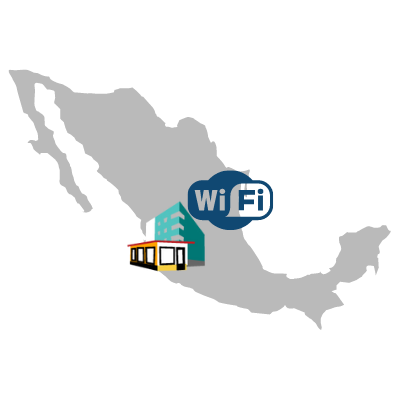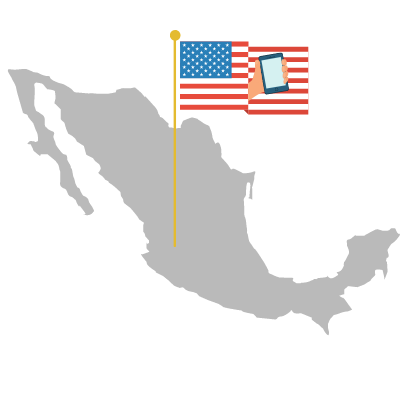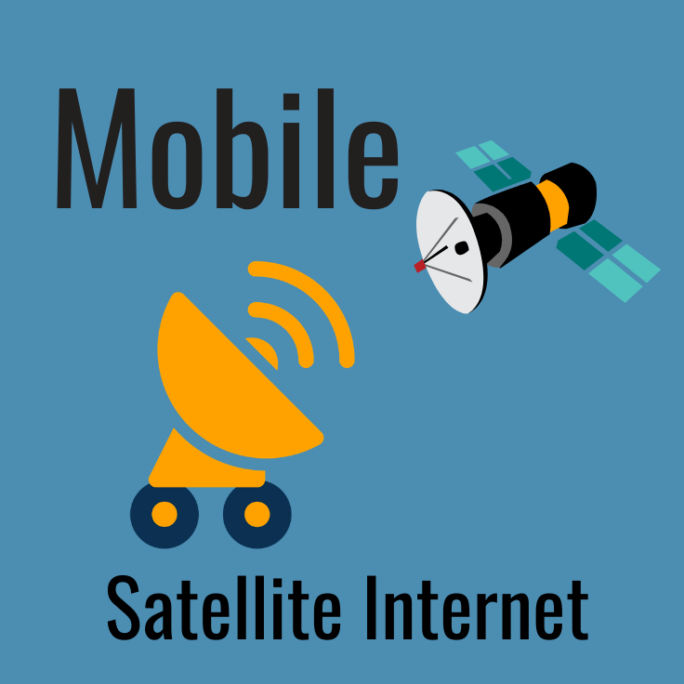RV Mobile Internet Options in Mexico
If you're planning to travel to Mexico by RV or boat, there are plenty of options for staying connected. Whether it's finding public Wi-Fi sources, using roaming data included on USA-based cellular plans, acquiring a SIM for a local Mexican provider, or using Starlink satellite internet - staying connected while traveling to Mexico is possible.
However, you may have to deal with slower speeds than you’re used to in the States, along with confusing roaming terms and data plan options.
This guide is here to help you review all of your options and decide on the best solution for you while traveling through Mexico.
If you're a member, please log in above to see your exclusive content.
Don't need a membership? Other ways you can support our work here:
-
As seen in our videos!
-
Get a FREE Month of Starlink!
And our team will get one too!
-
Get a FREE Month of T-Mobile Unlimited Data
Join the Calyx Institute, and get a bonus month - and we do too!
-
Save $20 on Visible
Verizon's prepaid phone plan, we also get a $20 credit.
-
Leave a Tip!
Send our team some beer money!!
-
Share About Us!
Link to our content, tell others about MIRC. It's Free!
It is with huge gratitude to our members for making the free unbiased educational content on our site possible. We're not sponsored, you'll find no 3rd party ads and we don't sell gear or data plans.
Our members get exclusive access to our in-depth content, classrooms, vendor discounts (that can save you more than membership!), alerts, insider info and interactive guidance. They can even book private advising sessions.
If mobile internet is an important part of your lifestyle, consider helping make MIRC possible by joining or supporting our mission.
International Mobile Internet Tips Video
Our international video overviews some general tips for getting mobile internet while traveling to Mexico by RV or boat:
You can also use our International Resources Page to access all of our guides to international & OCONUS travel, including: Canada, Mexico, Alaska, Bahamas and Global. We even have a guide for our Canadian friends for keeping connected in Canada & the USA.
Wi-Fi in Mexico
 Public Wi-Fi hotspots are widely available across Mexico, even in some of the country’s more rural areas.
Public Wi-Fi hotspots are widely available across Mexico, even in some of the country’s more rural areas.
Relying on Wi-Fi is the simplest way to stay connected in Mexico since you do not need to secure any special hardware or plans in advance. Wi-Fi works exactly the same in Mexico as it does in the USA, and you can use all your current equipment.
When traveling outside the USA, Wi-Fi will likely be your cheapest and easiest connectivity solution, especially if you’re only going to be in an area for a brief time when tracking down other options may not be worthwhile.
Aside from campgrounds, Wi-Fi hotspots are often accessible from cafes, coffee shops, restaurants, libraries, breweries, and more.
As with all public Wi-Fi, the usual caveats apply. Expect intermittent speeds, be prepared to connect in crowded public places lacking in privacy and quiet, and take precautions to keep your connection secure. Using a virtual private network (VPN) may be a smart way to protect yourself when regularly surfing on public international Wi-Fi.
Of course, public Wi-Fi hotspots will vary from free to paid, and the connection quality will vary substantially.
Having Wi-Fi repeating gear on board can help improve your connectivity situation if the prime issue is increasing the range that the gear in your RV can pick up a hotspot signal. Often, no amount of gear will make any difference. Upstream connections are very often limited, especially in small remote towns. And no amount or type of gear will increase the speeds or availability of the Wi-Fi access point itself.
We are also huge proponents of being especially considerate of others sharing the same Wi-Fi network as you. Streaming video should only be attempted if you have gotten an explicit 'OK' from the network manager. Don't be the one who drags the internet to a crawl for everyone. In some rural areas, there is just not a lot of connectivity to go around.
For more info and tips on extending your Wi-Fi capabilities: Getting Better Wi-Fi – Selecting Long Range Wi-Fi Extending Gear
Wi-Fi Calling Tip: Every one of the main U.S. cellular carriers supports Wi-Fi Calling on compatible phones. If your phone supports this, you can make and receive text messages and voice calls over Wi-Fi, even if you have no cellular service.
Make sure to set up Wi-Fi Calling before your trip to Mexico, and then you can leave your phone in airplane mode (but with Wi-Fi turned on) to still be able to make calls when you need to, assuming you can find Wi-Fi that is.
Roaming on Cellular Data Plans in Mexico
 Roaming is when a cellular carrier has agreements with other networks to utilize their towers, helping the carrier provide connectivity to their customers who are just passing through areas they don’t directly service themselves.
Roaming is when a cellular carrier has agreements with other networks to utilize their towers, helping the carrier provide connectivity to their customers who are just passing through areas they don’t directly service themselves.
Behind the scenes, the carriers may be charging each other for any usage while roaming onto their networks, thus the carriers manage their costs by having specific roaming policies on their plans.
There are two main types of roaming - domestic and international.
When roaming internationally, many U.S. carrier plans differentiate between North American roaming and global roaming. This means that their policies may be completely different when traveling in Canada or Mexico than when traveling further afield.
It's very important to know the exact terms of your plan. Some plans might roam just as if you're at home, some might include a daily or monthly cap when across borders and other plans might not include any international roaming at all.
Also, since roaming agreements aren't intended for primary international use - many plans have limits for how long you can travel abroad before roaming is shut off. In addition, most U.S.-based plans require you to activate the plan in the U.S. before crossing the border and attempting to use it.
All of the U.S.-based cellular carriers have vastly improved their international roaming agreements in recent years - making it even easier to stay connected when you cross borders.
Warning: If your plan doesn't have generous international roaming limits, be extra careful when traveling near borders. Your cellular device may pick up on international towers and you may unintentionally be roaming. Even within a few miles of a border.
The roaming setting on many devices only turns off domestic roaming, not international roaming. So be sure to TURN OFF any devices that don't have international roaming allowances when near or crossing borders.
Data Saving Tips for Using Capped Plans
 As noted above, most U.S.-based plans that permit data roaming into other countries place data usage caps on the roaming portions of those plans. If you are purchasing a local SIM card to use in another country, you may also find yourself dealing with data caps. Currently viable satellite-based plans also often have data caps.
As noted above, most U.S.-based plans that permit data roaming into other countries place data usage caps on the roaming portions of those plans. If you are purchasing a local SIM card to use in another country, you may also find yourself dealing with data caps. Currently viable satellite-based plans also often have data caps.
So how can you make the most of your data limits?
We've got a complete resource - with tips for lowering data usage - in our guide:
Managing Bandwidth: Common Data Hogs
Member Exclusive Content Below
Member Exclusive Content In This Guide
Has this guide been helpful so far?
Well.. there's a lot more below available to our members. As well as dozens of other guides like this, videos, classrooms, forums, webinars and more. All specifically created for helping keep RVers, cruisers and nomads online.
Consider Becoming a Member
If mobile internet is an important part of your lifestyle, a membership can help keep you connected with these exclusive benefits:
- in-depth exclusive content
- interactive guidance
- vendor discounts
- alerts & insider tips
- classroom
- community
Free Content Like This Made Possible By Our Members!
We are community funded via our premium membership program - allowing us to focus on creating unbiased quality, in-depth, constantly updated content. We don't accept 3rd party advertising, we're not sponsored and we don't sell 'stuff'.
Already a member?
Log in to continue with this guide.
Check out the Topics Covered in the Member Section:
USA Cellular Carrier Roaming Policies In Mexico
Each carrier and plan has its own roaming policies. In this section, we track the Mexican roaming policies for current and legacy plans on each of the major U.S. carriers and Google Fi.
Cellular Frequency Bands Used in Mexico
Getting the best cellular service means having equipment optimized for a carrier's network - this section tracks the cellular bands utilized by the Mexican carriers.
Getting Local Service on Mexican Cellular Carriers
For extended stays in Mexico, it may be best to seek out a local plan - which isn't necessarily easy without a Mexican billing address.
Satellite Internet in Mexico
Satellites have coverage maps too - this section tracks which mobile satellite services have you covered down South.
VPN Service: Virtually Getting Back to the USA
Once you cross the border, you may find your favorite websites and streaming services block international traffic. This section has some tips on getting around those blocks.
Summary: Connectivity Requires Planning and Flexibility
The allure of our neighbor to the South is magical for many U.S.-based RVers and cruisers. If Mexico has caught your eye, rest assured that you can explore the vast country of Mexico while still maintaining some semblance of connectivity. Be prepared to research, plan, and be flexible, but know that for most, maintaining a decent mobile internet connection is possible.
Additional Reading
Related Guides:
Explore the Resource Center
Have Questions?
Join our 'Library Desk':
Internet for RVers & Cruisers Facebook Group
We cross post news articles and guides, and can help point you in the right direction to our content here on the resource center.
It is with gratitude to our premium members that we're able to offer our free content - and for that, they also have access to our member Q&A areas for more in-depth guidance.
Become a Member
 The MIA is our premium membership - designed for those who consider mobile internet an important part of their lifestyle.
The MIA is our premium membership - designed for those who consider mobile internet an important part of their lifestyle.
In thanks for making content like this possible, we offer a bunch of additional perks. From interactive guidance, in-depth member exclusive content, discounts, alerts, classroom and ability to book private advising sessions.
Stay In the Know
We're constantly tracking the industry and analyzing new developments for mobile travelers. If you'd like to receive updates, we offer several ways:
- Subscribe to our free monthly newsletter
- Subscribe to our News Stories RSS Feed
- Subscribe to our YouTube Channel
- Follow our Facebook Page











 Mobile Internet Resource Center (dba Two Steps Beyond LLC) is founded by Chris & Cherie of
Mobile Internet Resource Center (dba Two Steps Beyond LLC) is founded by Chris & Cherie of